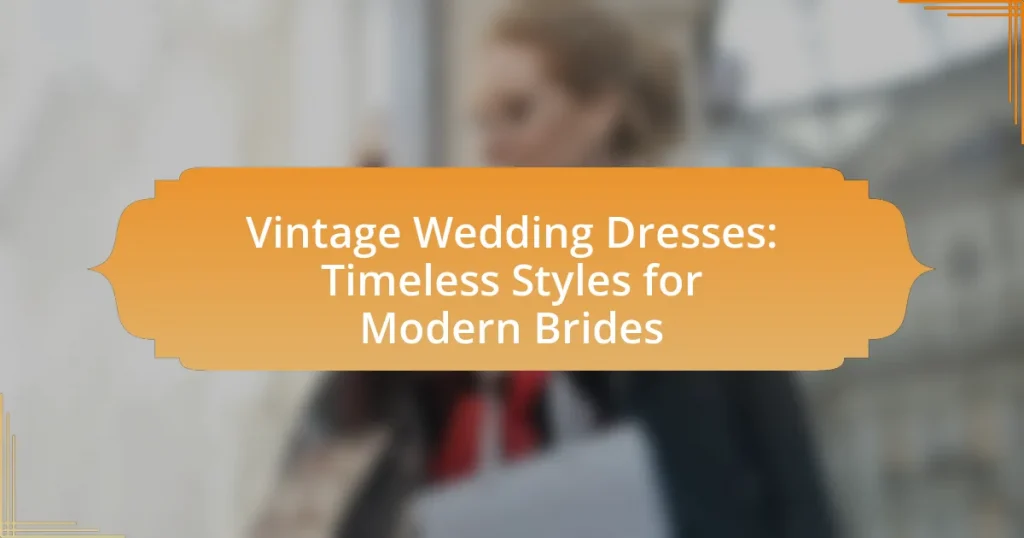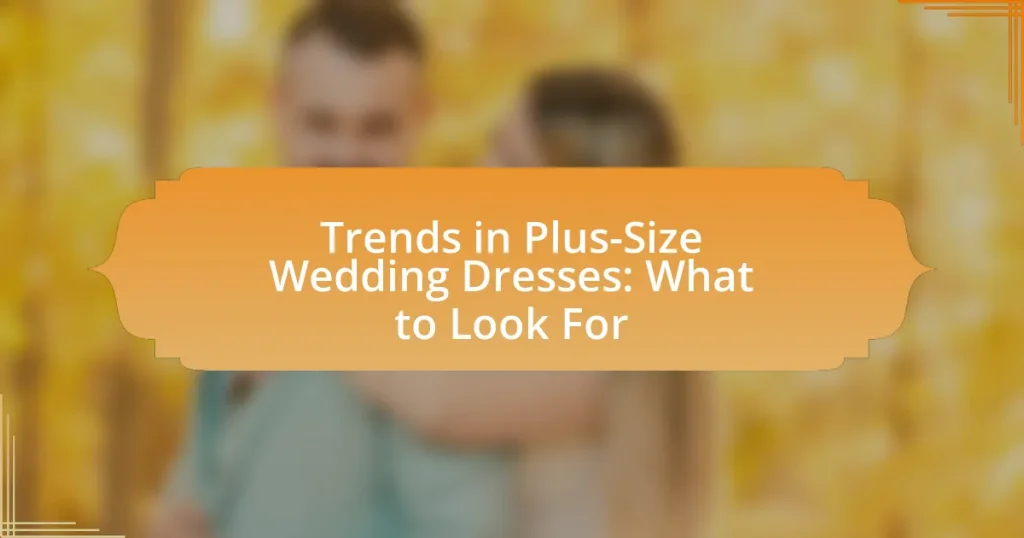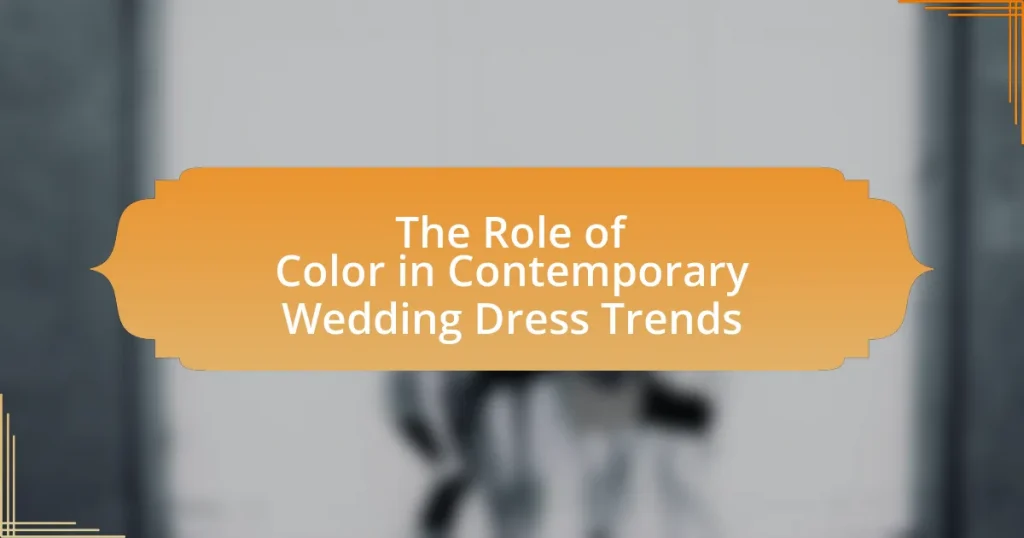Vintage wedding dresses are garments that embody styles from previous decades, particularly between the 1920s and 1980s, characterized by unique fabrics, intricate detailing, and distinctive silhouettes. This article explores the differences between vintage and modern wedding dress styles, highlighting the historical influences that shape vintage designs, such as the Victorian era, the Roaring Twenties, and the 1950s. It also discusses the materials commonly used in vintage dresses, the emotional significance they hold for brides, and the various styles available, including A-line, ball gown, and sheath silhouettes. Additionally, the article provides guidance on selecting the perfect vintage dress, considering factors like body shape, wedding theme, and authenticity, while offering tips for care and maintenance to ensure the longevity of these timeless garments.
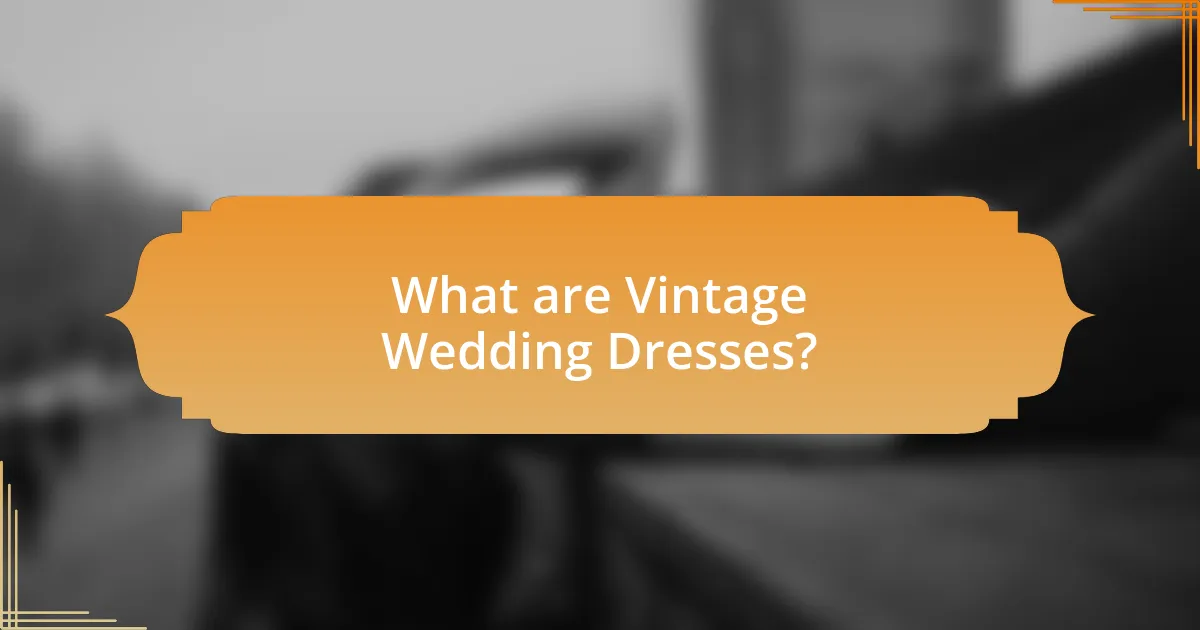
What are Vintage Wedding Dresses?
Vintage wedding dresses are garments that reflect styles and designs from previous decades, typically ranging from the 1920s to the 1980s. These dresses often feature unique fabrics, intricate detailing, and distinctive silhouettes that are characteristic of their respective eras. For example, a 1950s vintage wedding dress may showcase a full skirt and fitted bodice, while a 1920s dress might emphasize a drop waist and beaded embellishments. The appeal of vintage wedding dresses lies in their ability to offer brides a sense of nostalgia and individuality, as they often represent timeless elegance and craftsmanship that is less common in contemporary designs.
How do Vintage Wedding Dresses differ from Modern Styles?
Vintage wedding dresses differ from modern styles primarily in their design elements, fabrics, and cultural influences. Vintage dresses often feature intricate lace, beading, and unique silhouettes that reflect the fashion trends of their respective eras, such as the flapper styles of the 1920s or the romantic lines of the 1950s. In contrast, modern wedding dresses tend to emphasize minimalism, clean lines, and contemporary fabrics like chiffon and satin, often prioritizing comfort and versatility. Historical context supports this distinction, as vintage styles are rooted in specific time periods that influenced their aesthetic, while modern designs are shaped by current fashion trends and the evolving preferences of contemporary brides.
What historical periods influence Vintage Wedding Dress designs?
Vintage wedding dress designs are influenced primarily by the Victorian era, the Roaring Twenties, and the 1950s. The Victorian era (1837-1901) introduced intricate lace, high necklines, and long sleeves, emphasizing modesty and elegance. The Roaring Twenties (1920s) brought a shift to more relaxed silhouettes, with flapper styles featuring dropped waistlines and embellishments like beads and sequins. The 1950s showcased fuller skirts and fitted bodices, often characterized by the iconic “New Look” by Christian Dior, which celebrated femininity and glamour. Each of these periods contributes distinct elements that continue to inspire modern vintage wedding dress designs.
What materials are commonly used in Vintage Wedding Dresses?
Common materials used in vintage wedding dresses include lace, silk, satin, taffeta, and chiffon. Lace is often favored for its intricate designs and romantic appeal, while silk provides a luxurious feel and drape. Satin is known for its smooth finish and sheen, making it a popular choice for formal styles. Taffeta offers a crisp texture and structure, ideal for creating voluminous silhouettes, and chiffon is lightweight and flowy, perfect for ethereal looks. These materials have been historically significant in bridal fashion, reflecting the styles and craftsmanship of their respective eras.
Why are Vintage Wedding Dresses popular among Modern Brides?
Vintage wedding dresses are popular among modern brides due to their unique styles, historical significance, and sustainable fashion appeal. These dresses often feature intricate designs and craftsmanship that reflect the fashion trends of their respective eras, allowing brides to express individuality and stand out on their special day. Additionally, the growing awareness of sustainability in fashion encourages brides to choose vintage options, as they reduce waste and promote the reuse of beautiful garments. The combination of these factors makes vintage wedding dresses a favored choice for contemporary brides seeking both style and meaning in their wedding attire.
What emotional significance do Vintage Wedding Dresses hold?
Vintage wedding dresses hold significant emotional value as they embody nostalgia, tradition, and personal history. These garments often represent the love stories of previous generations, connecting modern brides to their ancestors and the cultural heritage of marriage. The intricate designs and craftsmanship of vintage dresses evoke a sense of timeless beauty and individuality, allowing brides to express their unique identities while honoring the past. Additionally, wearing a vintage dress can symbolize continuity and the enduring nature of love, making it a meaningful choice for many couples.
How do Vintage Wedding Dresses reflect personal style?
Vintage wedding dresses reflect personal style by allowing brides to express individuality through unique designs, fabrics, and historical influences. These dresses often feature distinctive elements such as lace, beading, and silhouettes that are not commonly found in contemporary bridal wear, enabling brides to showcase their personal aesthetic. For instance, a bride who favors the romanticism of the Victorian era may choose a gown with intricate lace detailing and a high neckline, while another who appreciates the simplicity of the 1920s flapper style might opt for a straight-cut dress with minimal embellishments. The choice of a vintage dress not only highlights personal taste but also connects the wearer to a specific cultural or historical narrative, making the wedding attire a meaningful representation of their identity.
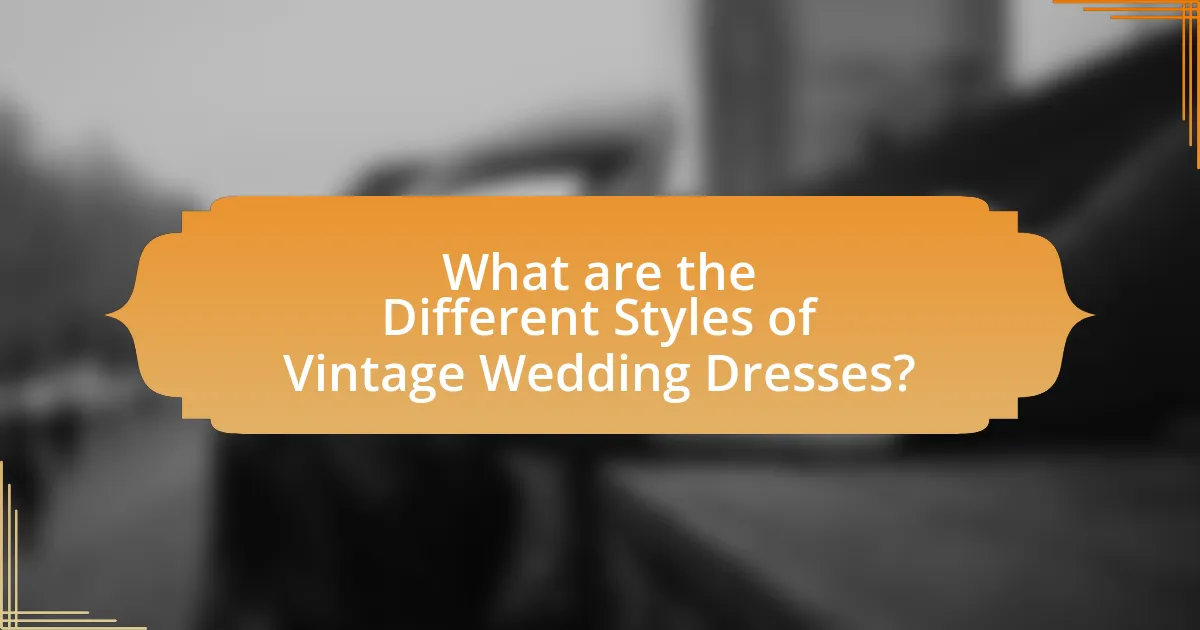
What are the Different Styles of Vintage Wedding Dresses?
Different styles of vintage wedding dresses include A-line, ball gown, sheath, tea-length, and mermaid silhouettes. A-line dresses, characterized by a fitted bodice that gradually flares out, are popular for their flattering shape. Ball gowns feature a full skirt and are often associated with fairy-tale weddings, while sheath dresses offer a more streamlined look that hugs the body. Tea-length dresses, which fall between the knee and ankle, evoke a retro charm, and mermaid dresses accentuate the curves before flaring out at the knee. These styles reflect various historical periods, such as the 1920s flapper style or the 1950s classic elegance, showcasing the timeless appeal of vintage designs.
What are the key characteristics of 1920s Vintage Wedding Dresses?
The key characteristics of 1920s vintage wedding dresses include a drop waist silhouette, intricate beadwork, and the use of lightweight fabrics like silk and chiffon. The drop waist design, which sits below the natural waistline, creates a relaxed and elongated look, reflecting the flapper style of the era. Beadwork and embellishments were commonly used to add glamour, often featuring Art Deco patterns that were popular during the 1920s. Additionally, the dresses often incorporated lace and fringe details, enhancing their vintage appeal. These elements collectively represent the fashion trends of the Roaring Twenties, characterized by a shift towards more liberated and modern styles for women.
How do 1920s styles influence modern bridal fashion?
1920s styles significantly influence modern bridal fashion through the incorporation of elements such as flapper-inspired silhouettes, intricate beadwork, and art deco motifs. The 1920s introduced a shift towards more relaxed and less restrictive designs, which is reflected in contemporary bridal gowns that often feature dropped waistlines and flowing fabrics. Additionally, the use of embellishments like sequins and lace, popularized during the Roaring Twenties, remains prevalent in today’s bridal collections, showcasing a blend of vintage charm and modern aesthetics. This enduring influence is evident in the work of designers who frequently draw inspiration from the era, creating gowns that celebrate both the elegance of the past and the preferences of modern brides.
What accessories complement 1920s Vintage Wedding Dresses?
Accessories that complement 1920s vintage wedding dresses include cloche hats, long pearl necklaces, feathered headbands, and beaded handbags. Cloche hats were a popular fashion accessory during the 1920s, often worn to enhance the elegant silhouette of the dresses. Long pearl necklaces added a touch of sophistication and were commonly layered to create a dramatic effect. Feathered headbands, often adorned with sequins or jewels, provided a glamorous touch that reflected the Art Deco style of the era. Beaded handbags were not only practical but also served as a stylish accessory that matched the intricate beadwork found on many vintage wedding dresses. These accessories collectively embody the essence of 1920s fashion, making them ideal complements to vintage wedding attire.
What defines the elegance of 1950s Vintage Wedding Dresses?
The elegance of 1950s vintage wedding dresses is defined by their structured silhouettes, luxurious fabrics, and intricate detailing. These dresses often feature fitted bodices, full skirts, and cinched waists, which create a classic hourglass shape that emphasizes femininity. The use of high-quality materials such as silk, lace, and tulle enhances their luxurious appearance, while embellishments like beading and embroidery add a touch of sophistication. Historical context shows that during the 1950s, fashion was heavily influenced by designers like Christian Dior, whose “New Look” revolutionized women’s fashion and emphasized elegance and glamour. This combination of design elements and historical significance solidifies the 1950s vintage wedding dress as a timeless symbol of elegance.
What silhouettes are popular in 1950s Vintage Wedding Dresses?
The popular silhouettes in 1950s vintage wedding dresses include the A-line, ball gown, and sheath styles. The A-line silhouette, characterized by a fitted bodice that gradually flares out to the hem, was favored for its flattering shape and versatility. Ball gowns featured a full, voluminous skirt that created a dramatic effect, often supported by crinolines, which was a hallmark of the era’s romantic aesthetic. Sheath dresses, which hugged the body closely, offered a more streamlined and modern look, appealing to brides seeking simplicity. These silhouettes reflect the fashion trends of the 1950s, influenced by designers like Christian Dior, whose “New Look” emphasized femininity and elegance.
How can brides incorporate 1950s styles into their wedding?
Brides can incorporate 1950s styles into their wedding by choosing vintage-inspired wedding dresses that feature classic silhouettes, such as A-line or tea-length designs, which were popular during that era. These dresses often include details like lace, tulle, and fitted bodices, reflecting the fashion trends of the 1950s. Additionally, brides can accessorize with items like birdcage veils, gloves, and pearl jewelry to enhance the vintage aesthetic. The use of pastel colors and floral patterns in decor and bridesmaid dresses can further evoke the charm of the 1950s, creating a cohesive theme throughout the wedding.
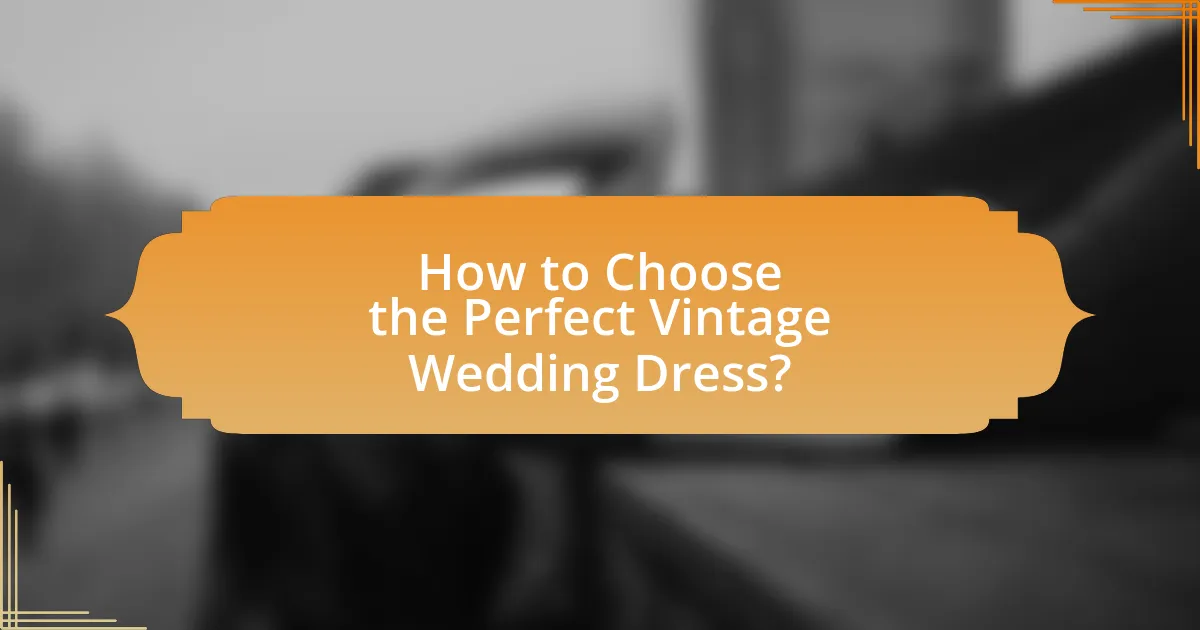
How to Choose the Perfect Vintage Wedding Dress?
To choose the perfect vintage wedding dress, first identify your preferred vintage era, such as the 1920s flapper style or the 1950s tea-length silhouette. Each era has distinct characteristics that influence the dress’s design, fabric, and overall aesthetic. For example, the 1920s featured drop-waist dresses with intricate beadwork, while the 1950s emphasized fitted bodices and full skirts.
Next, consider your body type and how different styles will complement your figure. A-line dresses are universally flattering, while mermaid styles may suit those with hourglass shapes. Additionally, pay attention to the dress’s condition, ensuring it is free from significant damage or stains, as vintage pieces can be delicate.
Finally, ensure the dress aligns with your wedding theme and personal style, as this will enhance your overall look on your special day. Researching reputable vintage shops or online marketplaces can also provide a wider selection and help you find a dress that meets your criteria.
What factors should brides consider when selecting a Vintage Wedding Dress?
Brides should consider the dress’s authenticity, fit, and condition when selecting a vintage wedding dress. Authenticity ensures the dress reflects the desired era, which can enhance the wedding’s theme. The fit is crucial, as vintage sizes often differ from modern sizing; brides may need alterations for a perfect fit. The condition of the dress is also important; it should be free from significant damage or stains, as this affects both appearance and longevity. According to a study by the Costume Society of America, understanding the historical context of vintage dresses can also influence a bride’s choice, ensuring the dress aligns with her personal style and the wedding’s overall aesthetic.
How does body shape influence the choice of a Vintage Wedding Dress?
Body shape significantly influences the choice of a Vintage Wedding Dress by determining which styles and silhouettes will flatter the bride’s figure. For instance, an hourglass shape often suits fitted bodices and A-line skirts, which accentuate curves, while a pear shape may benefit from dresses that feature a fitted top and a flared skirt to balance proportions. Additionally, brides with an apple shape might prefer vintage styles that offer empire waists or flowing fabrics to create a more streamlined appearance. Historical trends also play a role; for example, the 1950s silhouette, characterized by a cinched waist and full skirt, is particularly flattering for many body types, making it a popular choice among brides seeking vintage aesthetics.
What role does the wedding theme play in selecting a Vintage Wedding Dress?
The wedding theme significantly influences the selection of a Vintage Wedding Dress by guiding the style, color, and overall aesthetic of the dress. For instance, a rustic theme may lead a bride to choose a dress with lace and floral details, reminiscent of vintage styles from the early 20th century, while a glamorous vintage theme might prompt the selection of a dress with Art Deco elements, characterized by intricate beadwork and bold silhouettes. The alignment of the dress with the wedding theme ensures a cohesive look that enhances the overall atmosphere of the event, making it memorable and visually appealing.
What tips can help brides find authentic Vintage Wedding Dresses?
Brides can find authentic vintage wedding dresses by researching reputable vintage shops and online marketplaces that specialize in vintage clothing. These platforms often provide detailed descriptions and provenance of the dresses, ensuring authenticity. Additionally, brides should familiarize themselves with vintage fashion eras and styles to identify genuine pieces, as certain characteristics, such as fabric types and construction techniques, can indicate authenticity. Engaging with vintage fashion communities, both online and offline, can also provide valuable insights and recommendations for trustworthy sources.
Where are the best places to shop for Vintage Wedding Dresses?
The best places to shop for vintage wedding dresses include specialized vintage boutiques, online marketplaces, and thrift stores. Vintage boutiques often curate collections from specific eras, ensuring authenticity and quality. Online marketplaces like Etsy and eBay provide a wide range of options from various sellers, allowing for easy comparison and access to unique pieces. Thrift stores can yield unexpected finds at lower prices, making them a valuable resource for budget-conscious brides. These venues are known for their diverse selections and the potential for discovering one-of-a-kind dresses that reflect personal style and history.
How can brides ensure the quality of a Vintage Wedding Dress?
Brides can ensure the quality of a vintage wedding dress by thoroughly inspecting the fabric, stitching, and overall condition of the garment. High-quality vintage dresses are often made from durable materials like silk or lace, and the stitching should be even and secure, indicating craftsmanship. Additionally, brides should check for any signs of wear, such as fraying, discoloration, or stains, which can affect the dress’s integrity. Research shows that vintage dresses from reputable designers or well-known eras, such as the 1920s or 1950s, tend to have better construction and materials, enhancing their quality.
What are the best practices for caring for Vintage Wedding Dresses?
The best practices for caring for vintage wedding dresses include proper storage, gentle cleaning, and regular inspections. Storing vintage wedding dresses in a cool, dark, and dry environment helps prevent deterioration caused by light, humidity, and temperature fluctuations. Using acid-free tissue paper to stuff the dress and placing it in a breathable garment bag or box minimizes creasing and protects it from dust and pests. Gentle cleaning methods, such as dry cleaning by a professional experienced with vintage fabrics, preserve the integrity of delicate materials. Regular inspections for signs of wear, discoloration, or damage allow for timely repairs, ensuring the dress remains in good condition. These practices are essential for maintaining the quality and longevity of vintage wedding dresses, which can be sensitive to environmental factors and require special care.
